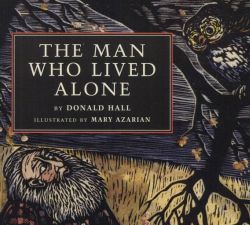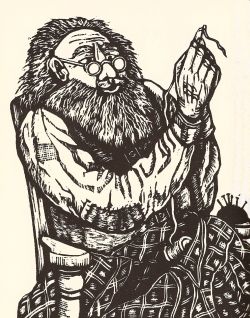Donald Hall's The Man Who Lived Alone

Donald Hall is a celebrated American poet, novelist, literary critic -- and writer of books for children, the latter characterized by strong images of rural Americana and New England.
Hall's children's book The Man Who Lives Alone (Boston: Godine, 1984) exemplifies this genre, especially being enhanced by the classic woodblock art of illustrator Mary Azarian complementing the text. (Hall lives in New Hampshire and Azarian lives in Vermont.)
The unnamed protagonist of the story "built himself a camp on the side of Ragged Mountain and lived there alone in one big room where he kept the things he collected ..." The protagonist is a classic wilderness hermit (a "camp" being a cabin without electricity or running water) living self-sufficiently in a rural setting, near mountains. (There are Ragged Mountains in Virginia, mentioned by Edgar Allan Poe, but these are in New Hampshire, in fact, within sight of Hall's home!)
The hermit collects odds and ends such as nails, newspapers, empty wasps' nests. He became a hermit from troubled upbringing, a father whom the book does not detail but who was an abusive and violent drunkard too impoverished to care for his two children. The protagonist and his younger sister go separately to live with other relatives, and he grows up learning carpentry and other handy skills from this peaceful and supportive family. Years later, his father returns to claim but, but he soon runs away to tramp through the whole country, from big cities to the Pacific coast, returning when he was no longer a minor.
The protagonist moves hear his generous cousins, and helps them farm, he "living alone and taking care of himself," then helping the next generation when the old couple pass away.
 Having established
that the
hermit is not a recluse, the story
concentrates on the protagonist's daily life. He wears a beard
except in summer, takes care of a donkey named Old Beauty and befriends
an owl named Grover. He, canned peas, tomatoes, and apples as
applesauce from his
garden and orchard, and ate one woodchuck and one deer annually. He
took up odd jobs roofing, toolmaking, and working on roads to
have spending money and pay his taxes. The hermit was skillful enough
that he stitched and repaired his own clothes rather than buy new
clothes, made his own maple sugar, grafted apple tree varieties, and
read old newspapers. When he was old, he enjoyed reminiscing with
his now widowed cousin. But mostly he stayed in his camp, daydreaming
about the past. The book ends discretely with a warm portrait of the
great bearded hermit in old age, the "man who lived alone."
Having established
that the
hermit is not a recluse, the story
concentrates on the protagonist's daily life. He wears a beard
except in summer, takes care of a donkey named Old Beauty and befriends
an owl named Grover. He, canned peas, tomatoes, and apples as
applesauce from his
garden and orchard, and ate one woodchuck and one deer annually. He
took up odd jobs roofing, toolmaking, and working on roads to
have spending money and pay his taxes. The hermit was skillful enough
that he stitched and repaired his own clothes rather than buy new
clothes, made his own maple sugar, grafted apple tree varieties, and
read old newspapers. When he was old, he enjoyed reminiscing with
his now widowed cousin. But mostly he stayed in his camp, daydreaming
about the past. The book ends discretely with a warm portrait of the
great bearded hermit in old age, the "man who lived alone."
¶
